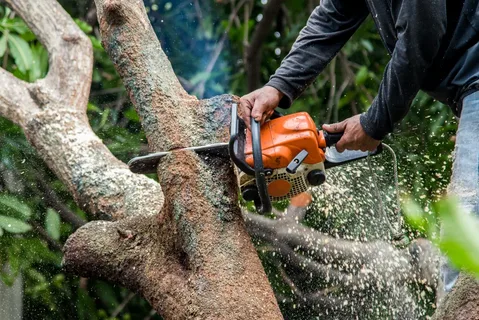Tree removal is a critical task that requires expertise, precision, and safety considerations. Whether you’re dealing with a dying tree, a storm-damaged one, or simply need to clear space for a new project, understanding the essentials of removing trees is paramount. In this blog, we will explore the various aspects of the removal of trees, the importance of pruning trees, and provide actionable insights for homeowners and property managers.
Understanding the Need for Removal of Trees
Tree removal is often necessary for several reasons:
- Safety Hazards: Dead or dying trees can pose significant safety risks. They are prone to falling during storms or high winds, which can result in property damage or personal injury.
- Space Management: Trees that grow too close to buildings, power lines, or other structures can cause problems. Their roots can damage foundations, while overhanging branches may pose a threat.
- Health of Other Trees: Sometimes, one tree’s disease or pest infestation can spread to nearby healthy trees. Removing the affected tree can prevent this.
- Aesthetic and Landscaping Needs: Homeowners may need to remove trees to enhance the appearance of their property or make room for landscaping projects.
The Tree Removal Process
Removal of trees is a complex process that involves several steps to ensure it is done safely and efficiently:
- Assessment: A professional tree service will first assess the tree and the surrounding area to plan the removal. This includes evaluating the tree’s health, size, and location.
- Permission and Permits: Depending on your location, you may need permits to remove a tree. It’s essential to check local regulations.
- Preparation: The area around the tree will be cleared to create a safe working space. This may involve removing obstacles and ensuring no people or pets are nearby.
- Cutting: Using specialized equipment, professionals will cut the tree down in a controlled manner. This often involves cutting the tree in sections, starting from the top.
- Removal and Cleanup: After the tree is down, it will be cut into manageable pieces and removed from the property. Stump removal or grinding may also be performed to ensure the area is clear.
Why You Should Hire Professionals
The removal of trees is not a DIY project. Here are some reasons why hiring professionals is crucial:
- Safety: Professional tree-cutting services have the necessary training and equipment to perform the job safely. They can handle the risks associated with large or precariously positioned trees.
- Efficiency: Experienced professionals can complete the job quickly and efficiently, minimizing disruption to your property.
- Proper Equipment: removal of trees requires specialized tools such as chainsaws, cranes, and stump grinders. Professionals have access to and know how to use this equipment.
- Insurance and Liability: Reputable tree-cutting companies carry insurance to cover any potential damages or injuries that may occur during the process.
The Importance of Tree Trimming
While tree removal is sometimes necessary, regular trimming of trees can prevent the need for it. The trimming of trees involves the selective removal of branches to improve the tree’s health, appearance, and safety. Here’s why tree trimming is essential:
- Promotes Healthy Growth: Trimming removes dead or diseased branches, allowing the tree to focus its energy on healthy growth.
- Enhances Safety: Removing weak or overhanging branches reduces the risk of them falling and causing injury or damage.
- Improves Appearance: Regular trimming can help maintain a tree’s shape and enhance the overall appearance of your property.
- Increases Sunlight and Airflow: Trimming can improve sunlight penetration and air circulation, benefiting both the tree and the plants below.
Signs Your Tree Needs Trimming
Regular inspections of your trees can help you determine when they need trimming. Look out for:
- Dead or Dying Branches: These are often easy to spot as they may be dry, brittle, or devoid of leaves.
- Dense Canopy: If the tree’s canopy is too thick, it can block sunlight and air from reaching the interior branches and ground below.
- Overhanging Branches: Branches that hang over your house, driveway, or power lines should be trimmed to prevent potential hazards.
- Signs of disease: fungal growth, cracks, or splits in the bark, and unusual leaf coloration are signs that a tree may need attention.
DIY Tree Cutting Tips
While major tree removal or trimming should be left to professionals, homeowners can handle minor trimming tasks. Here are some tips:
- Use the Right Tools: Ensure you have the proper tools, such as hand pruners, loppers, and a pruning saw.
- Cut at the Right Time: The best time to trim most trees is during their dormant season, usually in late winter.
- Make Clean Cuts: Ensure your cuts are clean and angled to prevent water from settling on the cut surface.
- Avoid Over-Trimming: Removing too much foliage can stress the tree. Follow the “one-third rule,” which means never removing more than one-third of the tree’s canopy at a time.
Conclusion
The removal of trees and trimming are essential tasks for maintaining the safety, health, and beauty of your property. While tree trimming can often be managed by homeowners, removal of trees should always be handled by professionals to ensure safety and efficiency. Regular maintenance and inspection of your trees can prevent many common issues and keep your landscape looking its best.
For professional and reliable tree removal services, trust Diamond Tree Company. Contact us today to schedule an assessment and ensure the health and safety of your property.
